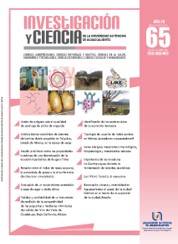Aceite de orégano sobre la calidad de pechuga de pollos de engorda
DOI:
https://doi.org/10.33064/iycuaa2015653576Palabras clave:
esencial, carne, carvacrol, timol, color, análisis proximalResumen
El aceite esencial de orégano (Lippia berlandieri Schauer) en dietas para pollo de engorda fue evaluado sobre la calidad de su pechuga. Se distribuyeron 162 pollos de 1 día (d) de edad (Ross) en nueve tratamientos (dietas), representados por la combinación de OC (60% carvacrol) y OT (40% timol); cada aceite consistió de una concentración de 0, 400 y 800 mg/kg. Los tratamientos (OC + OT) fueron: T1 0 + 0, T2 400 + 0, T3 800 + 0, T4 0 + 400, T5 400 + 400, T6 800 + 400, T7 0 + 800, T8 400 + 800, y T9 800 + 800. La calidad de la pechuga fue afectada (P<0.05) por los aceites de orégano. T7 disminuyó pH y aumentó retención de agua, T3 redujo conductividad eléctrica. T9 incrementó luminosidad y tendencia al color amarillo. T6 incrementó humedad y disminuyó ceniza, T3 aumentó proteína y T8 aumentó grasa.
Descargas
Citas
AOAC (ASSOCIATION OF OFFICIAL ANALYTICAL CHEMISTS). USA: 16th ed. Washington, DC., 1998.
CHO, J. H. et al. Effects of phytogenic feed additive on growth performance, digestibility, blood metabolites, intestinal microbiota, meat color and relative organ weight after oral challenge with Clostridium perfingens in broilers. Livestock Science, 160(1): 82-88, 2014. DOI: https://doi.org/10.1016/j.livsci.2013.11.006
ELEROĞLU, H. et al. Comparison of meat quality and fatty acid profile in slow-growing chicken genotypes fed diets supplemented with Origanum vulgare or Melissa officinalisleaves under the organic system. Italian Journal of Animal Science, 12(3): 395-403, 2013. DOI: https://doi.org/10.4081/ijas.2013.e64
FLETCHER, D. L. Poultry meat quality. World’s Poultry Science Journal, 58(2): 131-145, 2002. DOI: https://doi.org/10.1079/WPS20020013
HASHEMI, S. R. y DAVOODI, H. Phytogenics as new clase of feed additive in poultry industry. Journal of Animal and Veterinary Advances, 9(17): 2295-2304, 2010. DOI: https://doi.org/10.3923/javaa.2010.2295.2304
HONG, J. C. et al. Effects of supplemental essential oil on growth performance, lipid metabolites and immunity, intestinal characteristics, microbiota and carcass traits in broilers. Livestock Science, 144(3): 253-262, 2012. DOI: https://doi.org/10.1016/j.livsci.2011.12.008
KIM, Y. J. et al. Effect of dietary garlic bulb and husk on the physicochemical properties of chicken meat. Poultry Science, 88(2): 398-405, 2009. DOI: https://doi.org/10.3382/ps.2008-00179
KIRKPINAR, F. et al. Effects of dietary oregano and garlic essential oils on carcass characteristics, meat composition, colour, pH and sensory quality of broiler meat. British Poultry Science, 55(2): 157-166, 2014. DOI: https://doi.org/10.1080/00071668.2013.879980
KIRKPINAR, F. et al. Effects of oregano and garlic essential oils on performance, carcase, organ and blood characteristics and intestinal microflora of broilers. Livestock Science, 137(1-3): 219-225, 2011. DOI: https://doi.org/10.1016/j.livsci.2010.11.010
LEE, K. W. et al. Dietary carvacrol lowers body weight gain but improves feed conversion in female broiler chickens. The Journal Applied Poultry Research, 12(4): 394-399, 2003. DOI: https://doi.org/10.1093/japr/12.4.394
LEE, S. et al. Use of electrical conductivity to predict water holding capacity in post-rigor pork. Meat Science, 55(4): 385-389, 2000. DOI: https://doi.org/10.1016/S0309-1740(99)00166-7
LÓPEZ, K. P. et al. Broiler genetic strain and sex effects on meat characteristics. Poultry Science, 90(5): 1105-1111, 2011. DOI: https://doi.org/10.3382/ps.2010-01154
LUNA, A. et al. Effects of thymol and carvacrol feed supplementation on lipid oxidation in broiler meat. Poultry Science, 89(2): 366-370, 2010. DOI: https://doi.org/10.3382/ps.2009-00130
NRC (NATIONAL RESEARCH COUNCIL). Nutritional Requirements of Poultry. Washington D.C., USA, 1994.
ROOFCHAEE, A. et al. Effect of dietary oregano (Origanum vulgare L.) essential oil on growth performance, cecal microflora and serum antioxidant activity of broiler chickens. African Journal of Biotechnology, 10(32): 6177-6183, 2011.
SARANG, S. et al. Electrical conductivity of fruits and meats during ohmic heating. Journal of Food Engineering, 87(3): 351-356, 2008. DOI: https://doi.org/10.1016/j.jfoodeng.2007.12.012
SAS (STATISTICAL ANALYSIS SYSTEM). Institute Inc SAS/STAT user’s guide: Statics version 9. Cary, North Carolina, USA, 2002.
SYMEON, G. K. et al. Effect of dietary oregano essential oil supplementation for an extensive fattening period on growth performance and breast meat quality of female medium growing broilers. Canadian Journal of Animal Science, 89(3): 331-334, 2009. DOI: https://doi.org/10.4141/CJAS09027
TSAI, T. C. y OCKERMAN, H. W. Water binding measurement of meat. Journal of Food Science, 46(3): 697-701, 1981. DOI: https://doi.org/10.1111/j.1365-2621.1981.tb15328.x
YOUNG, J. F. et al. Ascorbic acid, α-tocopherol, and oregano supplements reduce stress-induced deterioration of chicken meat quality. Poultry Science, 82(8): 1343-1351, 2003. DOI: https://doi.org/10.1093/ps/82.8.1343
De páginas electrónicas
INEGI (INSTITUTO NACIONAL DE ESTADÍSTICA Y GEOGRAFÍA). México en Cifras: Información Nacional por Entidad Federativa y Municipios 2012. Recuperado el 23 de octubre de 2013, de http://www.inegi.org.mx/sistemas/mexicocifras/default.aspx?e=8.
SAGARPA (SECRETARÍA DE AGRICULTURA, GANADERÍA Y DESARROLLO RURAL). NORMA OFICIAL MEXICANA NOM-033-ZOO-1995, Sacrificio humanitario de los animales domésticos y silvestres. Diario Oficial de la Federación, 16 de julio de 1996. Recuperado el 22 de octubre de 2013, de http://www.economia-noms.gob.mx/noms/consultasAction.do
STARČEVIĆ, K. et al. Production performance, meat composition and oxidative susceptibility in broiler chicken fed with different phenolic compounds. Journal of the Science of Food and Agriculture, 2014, doi: 10.1002/jsfa.6805. DOI: https://doi.org/10.1002/jsfa.6805
Descargas
Publicado
Cómo citar
Licencia
Derechos de autor 2015 Gerardo Méndez Zamora, José Arturo García Macías, Eduardo Santellano Estrada, Lorenzo Antonio Durán Meléndez, Ramón Silva Vázquez

Esta obra está bajo una licencia internacional Creative Commons Atribución-NoComercial-CompartirIgual 4.0.
Las obras publicadas en versión electrónica de la revista están bajo la licencia Creative Commons Atribución-NoComercial-CompartirIgual 4.0 Internacional (CC BY-NC-SA 4.0)









